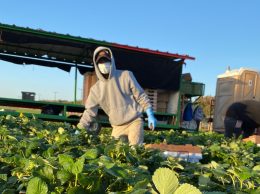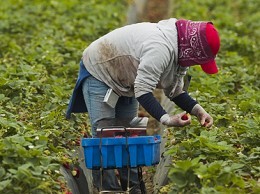Farmers fret over worker deficit in the fields
IN THIS ARTICLE
- Agribusiness Topic
- Dana Olsen Author
By Dana Olsen Friday, November 23rd, 2012
An agricultural labor shortage across the Tri-Counties is leaving some farmers wringing their hands and wondering whether a portion of next year’s crops may be left in the ground.
Agricultural officials and growers are reporting that for the 2012 harvest season, labor crews were 20 percent to 30 percent smaller than in years past, and the shortfall is only expected to get worse.
Much of the shortage is due to the relatively low number of Mexican immigrants crossing the border to work in the fields over the past few years. The contracted labor force, plus higher-than-normal yields of big crops such as strawberries and avocados, equals a problem for growers.
“The labor situation is getting tighter and tighter year by year,” Richard Quandt, president and general counsel of the Grower-Shipper Association of San Luis Obispo and Santa Barbara Counties, told the Business Times. The association has been heavily involved in issues surrounding farm labor for a number of years.
Quandt said there are very few native-born U.S. citizens who work in the fields, which means almost all the farm laborers on the Central and South coasts are immigrants from other countries. “There are fewer and fewer workers available. They tend to work when they’re young, then move into other jobs that are easier. What we’re seeing is that those workers are not being replaced by other workers.”
Ventura County Farm Bureau CEO John Krist said the situation is the same further south. The labor shortage has been a problem all over the Golden State for the past year, he said, and it’s expected to become more severe as the U.S. economy picks up, crop yields increase and political gridlock keep Mexican immigrants from crossing the border. “A lot of things are conspiring to drive labor demand up, and a lot of things are conspiring to drive labor supply down … And we’re afraid it’s going to be even worse next year.”
Ventura County is set for a huge avocado crop in 2013, and labor intensive fruits like strawberries and raspberries are also in for a banner year. Campbell Ranch owner Bob Campbell said the major moneymakers in Santa Barbara and San Luis Obispo counties — strawberries and wine grapes, respectively — are expected to post big numbers next year, as well.
At his ranch in Lompoc, Campbell grows lettuce, broccoli and cauliflower, and he said he’s seen the labor shortage from the ground. “Everyone, all summer long, struggled for enough people to try and get their crops harvested. Myself, just like most growers, had to walk over some crops,” he told the Business Times, adding that he’s growing more produce. “There’s definitely more demand.”
The additional demand for labor is going largely unfilled as Mexican immigrants, a group that makes up a substantial part of the agricultural workforce, are either returning home or remaining in their native country. According to Quandt of the Grower-Shipper Association, there are several reasons why working in the U.S. farm industry isn’t as attractive as it once was for immigrants.
First, it’s getting more difficult to cross the Mexico-U.S. border, both legally and illegally. The California side, Quandt said, is ratcheting down on enforcement of immigration laws, which means fewer and fewer illegal workers are taking their chances at sneaking across the border looking for work. At the same time, drug cartels on the Mexican side are creating a barrier between potential workers and the border.
There are also economic advantages for Mexican agricultural workers who choose to remain in their home country. Quandt and Krist of Ventura’s farm bureau both said that Mexico’s expanding economy and the stronger peso are making the country a more attractive place to work and live. “A recent study shows a reverse trend … we’re actually losing population to Mexico instead of gaining it,” Krist said. “Mexico’s economy has been improving, so there’s less incentive to seek work here.”
Solutions to the labor shortage problem are hard to come by because they’re largely reliant on federal immigration reform. Currently, most workers either cross the border illegally or through federal programs such as the H-2A Temporary Agricultural Program. Krist said that while the H-2A program works in other parts of the country, it’s impractical in California because there’s such a long list of requirements for employers, including providing costly housing and demonstrating that the local labor force is inadequate.
The California farming industry is pushing Congress to enact comprehensive immigration reform to open up legal channels for workers.
“I’m not necessarily saying to open the border,” Campbell of Campbell Ranch said, “but those people down there looking for work? Let them come work.”
Until there’s a solid, comprehensive immigration reform package that allows workers to cross the border, officials and farmers think it’s going to be an uphill battle. “It’s not a good situation,” Quandt said. “I do fear for when March and April come around.”










